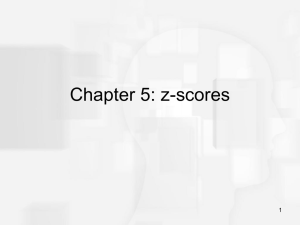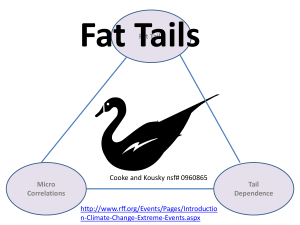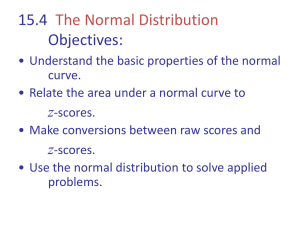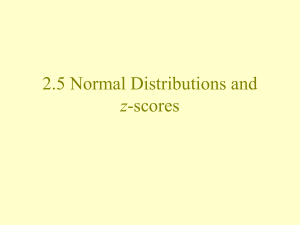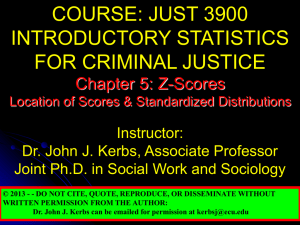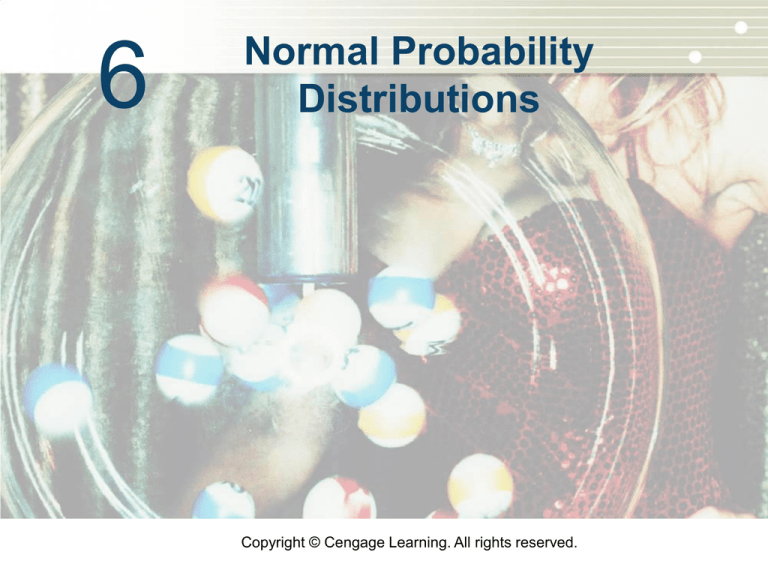
6
Normal Probability
Distributions
Copyright © Cengage Learning. All rights reserved.
6.4
Notation
Copyright © Cengage Learning. All rights reserved.
Notation
The z-score is used throughout statistics in a variety of
ways; however, the relationship between the numerical
value of z and the area under the standard NORMAL
Distribution Curve does not change. Since z is used with
great frequency, we want a convenient notation to identify
the necessary information.
The convention that we will use as an “algebraic name” for
a specific z-score is z(), where represents the “area to
the right” of the z being named.
3
Visual Interpretation of z()
4
Visual Interpretation of z()
Figures 6.6 and 6.7 are both visual interpretations of z().
Area Associated with z(0.05)
Figure 6.6
Area Associated with z(0.90)
Figure 6.7
5
Visual Interpretation of z()
Figure 6.6 depicts z(0.05) (read “z of 0.05”), which is the
algebraic name for z, such that the area to the right and
under the standard normal curve is exactly 0.05.
In a similar fashion, Figure 6.7 shows z(0.90) (read
“z of 0.90”), which is the value of z, such that 0.90 of the
area lies to its right.
6
Determining Corresponding
z Values for z()
7
Determining Corresponding z Values for z()
Visual representations like those in Figures 6.6 and 6.7
also have corresponding numerical values. Now let’s find
the numerical values of z(0.05), z(0.90), and z(0.95).
Area Associated with z(0.05)
Figure 6.6
Area Associated with z(0.90)
Figure 6.7
To find the numerical value of z(0.05), we must convert the
area information in the notation into information that we can
use with Table 3 in Appendix B.
8
Determining Corresponding z Values for z()
By subtracting 0.05 from 1, we get 0.95, the area to the left
of the z(0.05), which you can see in Figure 6.8.
Find the Value of z(0.05)
Figure 6.8
9
Determining Corresponding z Values for z()
When we look in Table 3, we look for an area as close as
possible to 0.9500.
We use the z that corresponds to the area closest in value.
When the value happens to be exactly halfway between the
table entries as above, always use the larger value of z.
Therefore, z(0.05) = 1.65.
10
Determining Corresponding z Values for z()
To find the numerical value of z(0.90), we need to subtract
the 0.90 area from 1, which results in an area of 0.10 to the
left of z(0.90). The 0.1000 area is the area we can use with
Table 3 in Appendix B; as shown in the diagram below.
11
Determining Corresponding z Values for z()
The closest values in Table 3 are 0.1003 and 0.0985, with
0.1003 being closer to 0.1000.
Therefore, z(0.90) is related to –1.28. Since z(0.90) is
below the mean, it makes sense that z(0.90) = –1.28.
12
Determining Corresponding z Values for z()
Because of the symmetrical nature of the normal
distribution, z() and z(1 – ) are closely related, with the
only difference being that one is positive and the other is
negative. We already found the value of z(0.05) = 1.65.
Now let’s find z(0.95).
z(0.95) is located on the left-hand side of the normal
distribution since the area to the right is 0.95.
13
Determining Corresponding z Values for z()
The area in the tail to the left then contains the other 0.05,
as shown in Figure 6.9.
Area Associated with z(0.95)
Figure 6.9
Using Table 3, z(0.95) = –1.65.
14
Determining Corresponding z Values for z()
Because of the symmetrical nature of the normal
distribution, z(0.95) = –1.65 and z(0.05) = 1.65 differ only in
sign and the side of the distribution to which they belong.
Thus, z(0.95) = –z(0.05) = –1.65.
In many situations, it will be more convenient to refer to the
area of the tail than to either the cumulative area or the
area to the right, so we can use this difference as an
alternative algebraic name for the z-values bounding a
left-side tail situation.
In general, when 1 – is larger than 0.5000, the notation
convention we will use is z(1 – ) = –z().
15
Determining Corresponding z Values for z()
The z() notation is used regularly in connection with
inferential situations involving the area of a tail (extreme
ends of a distribution curve—either left or right) region. In
later chapters this notation will be used on a regular basis.
The values of z that will be used regularly come from one
of the following situations:
(1) the z-score such that there is a specified area in one tail
of the normal distribution, or
(2) the z-scores that bound a specified middle proportion of
the normal distribution.
16
Determining Corresponding z Values for z()
When the middle proportion of a normal distribution is
specified, we can also use the “area to the right” notation to
identify the specific z-score involved.
17
Table 4 and Commonly Used
z Values
18
Table 4 and Commonly Used z Values
We already solved two commonly used one-tail situations;
z(0.05) = 1.65 is located so that 0.05 of the area under the
normal distribution curve is in the tail to the right and
z(0.90) = –1.28 is located so that 0.10 of the area under the
normal distribution curve is in the tail to the left.
Table 4, Critical Values of Standard Normal Distribution,
was designed to provide only the most commonly used
values of z when the area(s) of the tail regions are given.
Part A, One-Tailed Situations, is used when the area of a
tail is given. In order to examine this, let’s find the values of
z(0.05) and z(0.95) using Table 4.
19
Table 4 and Commonly Used z Values
Table 4A, One-Tailed Situations shows us:
Table 4A
z(0.05) = 1.65, and since the standard normal distribution is
symmetrical, the value of z(0.95) = –z(0.05) = –1.65.
20
Determining z-Scores for
Bounded Areas
21
Determining z-Scores for Bounded Areas
z-scores can also be determined for bounded areas of a
normal distribution. For example, we can find the z-scores
that bound the middle 0.95 of the normal distribution. Given
0.95 as the area in the middle (see Figure 6.10), the two
tails must contain a total of 0.05.
Area Associated with Middle 0.95
Figure 6.10
22
Determining z-Scores for Bounded Areas
Therefore, each tail contains
in Figure 6.11.
of 0.05, or 0.025, as shown
Finding z-Scores for Middle 0.95
Figure 6.11
23
Determining z-Scores for Bounded Areas
The right tail value, z(0.025), is found using Table 4, Part A,
One-Tailed Situations, as shown previously.
z(0.025) = 1.96, and since the standard normal distribution
is symmetrical, the value of z(0.975) = –z(0.025) = –1.96.
24
Determining z-Scores for Bounded Areas
Using Two Tails
You can use two tails to find the area as well. Given 0.95
as the area in the middle (Figure 6.11), the two tails must
contain a total of 0.05.
Finding z-Scores for Middle 0.95
Figure 6.11
25
Determining z-Scores for Bounded Areas
Table 4, Part B, Two-Tailed Situations, can be used when
the combined area of both tails (or the area in the center) is
given.
Locate the column that corresponds to = 0.05 or
(1 – ) = 0.95.
26
Determining z-Scores for Bounded Areas
From Table 4B we find z(0.05/2) = z(0.025) = 1.96.
Using the symmetry property of the distribution, we find
z(0.975) = –z(0.025) = –1.96.
Therefore, the middle 0.95 of the normal distribution is
bounded by –1.96 and 1.96.
27


